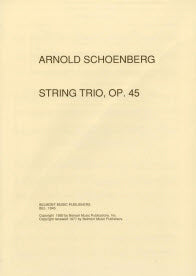
BELMONT MUSIC PUBLISHERS - 4541867
Schoenberg String Trio Op. 45 (Full Score)
Composer: Arnold Schoenberg
Publisher: Belmont Music Publishers
Instrumentation: Mixed
Format: Chamber Score
Schoenberg String Trio Op. 45 (Full Score)
Juilliard Store
144 West 66th Street
New York NY 10023
United States
Choose options
Schoenberg String Trio Op. 45 (Full Score)
Juilliard Store
144 West 66th Street
New York NY 10023
United States
Schoenberg String Trio Op. 45 (Full Score)
Juilliard Store
144 West 66th Street
New York NY 10023
United States
The String Trio op. 45 was commissioned by the music department of Harvard University for a symposium on Musical Criticism in spring 1947. It was premiered by members of the Walden String Quartet at Harvard (in Cambridge, Massachusetts) on 1 May 1947. Also contributing new works for the occasion were: Paul Hindemith (“Apparebit Repentina Dies”), Gian Francesco Malipiero (“La Terra”), Aaron Copland (“In the Beginning”), and Bohuslav Martinu (6th String Quartet). Schönberg had begun work on the piece already in June 1946, but the majority was composed between 20 August – i.e. only two-and-a-half weeks after Schönberg suffered a severe heart attack – and 23 September. This traumatic episode, which Schönberg survived only through an injection directly into his heart, took its toll on the 71-year-old composer, and Schönberg told Thomas Mann (as reported in “Die Entstehung des Doktor Faustus”) that his Trio reflected his physical and psychological suffering during this period. The single-movement work is divided into five sections: three “parts” and two “episodes.” Part three begins like Part one and recapitulates aspects of the whole work. Thematic development is spread throughout the work. The piece ends with a 12-note statement in the violin in which the basic motifs are presented. The variety of surface details (abrupt dynamic contrasts, expressionistic string effects, variations in tone) stand in contrast to the rigorous serialism that undergirds the work’s structure.
Camille Crittenden
© Arnold Schönberg Center
